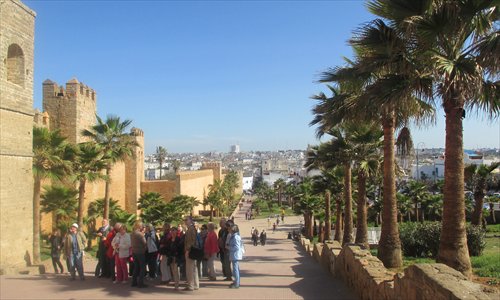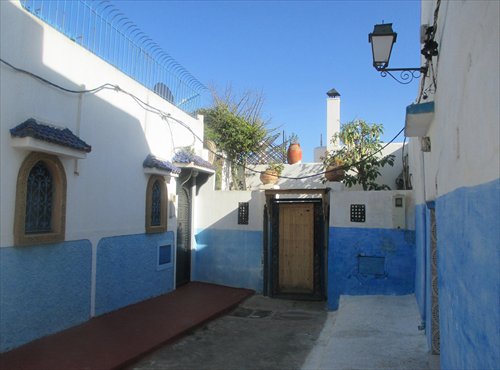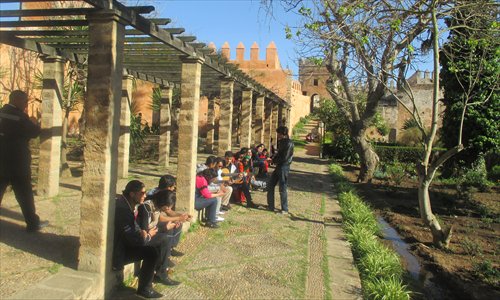There is more to Morocco than Casablanca

Tourists stand outside the Kasbah of the Udayas. Photo: Song Shengxia/GT

This week's destination

Whitewashed residences in an alleyway inside the Kasbah Photo: Song Shengxia/GT

A group of young people playing the guitar and singing Photo: Song Shengxia/GT
"Please come back to me in Casablanca. I love you more and more each day as time goes by." The moment I knew I was to take a business trip with a group of Chinese journalists to Morocco, my mind was full of romantic scenes from Casablanca, the 1942 movie about World War II intrigue starring Humphrey Bogart and Ingrid Bergman. Its theme song "As Time Goes By" rang in my ears. I fancied myself sipping coffee at Rick's Café in Casablanca, which I believed was where most of the movie was shot.
But it turned out I did not have the time for such an exotic experience. My schedule was packed with interviews. During the whole trip, I had to stay in Rabat, Morocco's capital, and travel to five different places in the country for interviews during five days and return to Rabat at night. Our guide added that Rick's Café never existed at all until 2004, when it was opened by a former US diplomat in Morocco to recreate the cinematic bar.
Despite a tight schedule, our organizer managed to squeeze time for us to tour Rabat. I was amazed to find that Rabat is full of history unknown to many tourists who flock only to Casablanca and Marrakesh.
The last day when I came to Casablanca to take a flight home, I no longer yearned for a stay at Rick's Café. Just before our flight took off I murmured, "Sorry, Casablanca. Rabat has stolen my heart."
Chellah
Everything came together to make our visit to Chellah, the ruins of an old Roman city, the highlight of our stay in Morocco - the mild temperature of 20 C, the clear blue sky and warm Mediterranean sun and the fact it was not as crowded as every attraction back in Beijing.
Situated on the outskirts of Rabat, Chellah is considered the oldest human settlement on the banks of the Bou Regreg River. When the Roman Empire conquered the northern part of Morocco in 40AD, they converted Chellah into a trading hub and named it Sala Colonia.
A drummer dressed in a long striped gown and another performer with cymbals greeted us at the gate, dancing merrily and humming a tune. I immediately got in a festive mood and paid 10 dirhams($1.23) to take a few photos with the two performers.
Entering the main gate, we were led to a path shaded by lush orange, olive, fig and other trees. The path leads to a viewing platform which allows for a better view of the whole site.
As we continued to venture along the path, on our left, we found the Roman ruins, which used to be a small trading post in ancient times. The damage to the site by an earthquake in 1755 made it difficult to discern what the functions of the structures scattered over the site were.
Far down the right were the ruins of a sanctuary, now home to a collection of Islamic artifacts. A tall stone-and-tile minaret stood out among the ruins.
Around the sanctuary enclosure are scattered royal tombs, where Sultan Abou el Hassan and his successors were buried. Among the ruins were pillars, arches, a school classroom and drainage and bathing facilities.
Just before we exited the cluster of tombs, we found a small pool enclosed with walls from three sides. According to our guide there are more than 40 eels in the pool although we unfortunately only saw two or three. It is said feeding the eels with hard-boiled eggs can enhance fertility and thus the pool still attracts women who wish to have an easy labor or as many children as they want.
Mausoleum and Hassan Tower
We entered the site from one gate guarded by two royal soldiers on horseback and holding a large Moroccan flag. The two guards remained formidable despite tourists posing beside them, taking endless photos.
The mausoleum, a holy place open to foreigners and non-Muslims, is home to the tombs of the current king's grandfather, King Mohammed V, the first king of independent Morocco and his two sons, the late King Hassan II and Prince Abdallah.
Though it was designed by a Vietnamese architect, the mausoleum is a masterpiece of classical Moroccan architectural craftsmanship. The exterior features white marble walls and a traditional green tiled roof.
Climbing the stairs, we reached the second floor which serves as a viewing platform that overlooks the three tombs. From there, tourists can take photos and admire the magnificent interior design. Below the platform, the tomb of King Mohammed V made of shining white marble is in the center with the two smaller ones flanking it.
Compared to the plain exterior, the interior of the mausoleum showcases unique Moroccan craftsmanship - the patterned mosaic tiled wall, which rises from the marble floor, and the sparkling, gold-laden roof with intricate carvings.
Walking out of the mausoleum, we faced Hassan Tower, built with red-rust colored sandstone. The tower was constructed in 1195 as an ambitious project to be the largest mosque in the Islamic world. However, construction was halted when Sultan Yacoub al-Mansour died four years later. The tower remains unfinished at 44 meters, only half of its intended height.
Just as we exited from the other gate, also guarded with two soldiers on horseback, we were fortunate to witness the changing of guards which happens every two hours.
The Kasbah of the Udayas
As we stepped off the minibus, we couldn't conceal our excitement. The Kasbah, originally an ancient fortress used to protect royalty from attacks, stands magnificently on a cliff over the Atlantic Ocean. Walking through its main gate, we followed a narrow lane to a souk, an outdoor market, where stalls display Moroccan delicacies, leather shoes, postcards and olive oil.
As the only group of people from Asia, we looked very foreign to locals. Some kids dashed toward us and cheerfully said "hello" in Japanese, obviously thinking we were from Japan. Later we found out from China's embassy in Rabat that Morocco is a tourist destination almost untapped by Chinese.
Passing the souk, we found ourselves among zigzagging alleyways, just like Beijing's hutong. Whitewashed residences are on each side and half are painted bright blue.
Further down, we came to a public garden with shops selling traditional Moroccan sweets and pastries and coffee houses. It is the perfect place for locals to enjoy coffee while overlooking the Bou Regreg River. A group of young people sat along a corridor, playing guitar and singing.
Bazaar
No tour to Rabat is complete without visiting the local bazaar. On an evening when a prearranged interview was canceled, our guide took us to a local bazaar. Entering from the Bab El Had gate, site of the Sunday market, we took Souika street, the biggest and probably busiest in the medina.
As the evening drew close, all walks of life converged on the street full of shops selling traditional silver mint tea kettles, cooking utensils, food, scarves and jewelry. There were shops selling traditional clothing and also those selling fake brand-name clothes.
Many people were dressed in traditional clothes. Interestingly, despite the hustle and bustle of the market, when the mosque's bells rang, some people stopped what they were doing to pray.
It is fine to bargain at the bazaar and you can start by offering half of what is offered by the vendors. We were particularly attracted to a store selling ceramics. The vendor only spoke Arabic. Luckily, one of the Chinese journalists in our group spoke Arabic. After half an hour of bargaining, almost everyone bought a dozen ceramic pieces, paying around 100 dirhams. Just as we were about to leave, the vendor called our "interpreter" and gave her a plate for free to express his thanks.
Rules of thumb
Getting there: There is no direct flight between China and Morocco. You can fly from Beijing to Doha, Dubai, Paris, Istanbul, Cairo, London, or Amsterdam, then transfer to a flight to Casablanca. There is a small airport in Rabat, which is used for both civil and military operations. Visitors usually get to Rabat from Casablanca, where the country's busiest airport is located, by train, minibus, cars or taxis.
Currency: The dirham is the Moroccan currency which you can purchase with dollars or euros at the local airports or banks. The Chinese yuan cannot be exchanged for dirham at local banks. Dollars and euros are also acceptable at big hotels and restaurants. Remember to convert dirham back to dollars or euros at local banks if you leave the country through Casablanca airport because there is no currency exchange service after you go through airport security.
Language: French is a very useful language in Morocco and the second most widely spoken language after Arabic. Some well-educated young people can also speak good English.
Tipping customs: It is advisable to prepare a good amount of small change in coins and notes as tipping is common in the country.